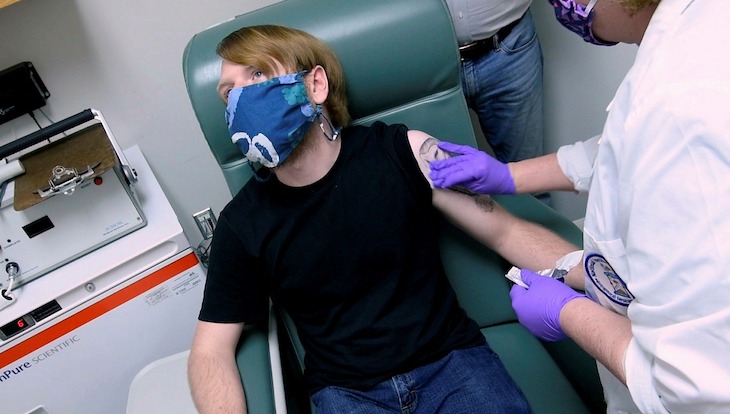
The Pfizer Covid-19 vaccine has done next to nothing to protect children from infection from the Omicron variant, data revealed by New York state officials on Monday shows.
Yet money-grabbing doctors in thrall to Big Pharma are still pushing the vaccine on gullible parents and innocent children.

BYPASS THE CENSORS
Sign up to get unfiltered news delivered straight to your inbox.
You can unsubscribe any time. By subscribing you agree to our Terms of Use
Latest Video
Researchers at the New York State Department Health gauged infection rates of minors who have had the Pfizer jab made available to them. Children were split into two age groups, one of children five to 11 and the other for children 12 to 17.
They found that the two-dose Pfizer shot was only 12 percent effective at preventing Omicron infection in the younger age group only one month after receival.

DailyMail report: The findings have far reaching implications on the use of the vaccines, and whether parents will want to get their children jabbed.
Children do not suffer much of a risk from the virus, with hospitalizations and deaths being especially rare.
The main argument in favor of vaccinating them is to prevent them from spreading the virus, though these findings imply that the vaccine does little to prevent that anyways.
In cities like New York, children as young as five years old were made to show proof of vaccine to enter indoor dining, fitness and entertainments establishments. Children also had to be vaccinated to take part in some school activities.
This likely influenced some parents’ decisions regarding the vaccine – as uptake for the shots has been relatively low in younger age groups – and now official data is coming from the state showing that the shot did little to protect the children from infection.
Some parents also had significant fears about potential side-effects of the vaccine, and took a risk to give their child the shot, only to now find out it potentially is not as effective as advertised.
‘I think we need to rethink this whole program of vaccinated adolescents and children. What is our objective?’ Dr Cody Meissner, the chief of pediatrics at Tufts Children’s Hospital in Boston and a member of the FDA’s Vaccines and Related Biological Products Advisory Committee, told DailyMail.com
Meissner has been a critic of the idea that all children need to be vaccinated, since the face little risk from the virus itselt while also suffering a risk of some serious side-effects like myocarditis.
New York researchers gathered data 852,384 children aged 12 to 17 and 365,502 aged five to 11 for the study.
The study, which is pre-print and pending peer-review, gathered data from the Omicron period of the pandemic, from December 2021 and January 2022.
Participants in the study were followed up with and compared to general figures from unvaccinated populations.
One major difference between the study groups is the dosage of the vaccine. While children aged 12 and older receive a 30 microgram shot, it is only ten micrograms for the five to 11 age group.
Researchers found that 28 to 34 days after receiving the second dose – about one month – vaccine effectiveness in the younger age group had waned from 67 percent to 11 percent against the variant.
This is compared to a much smaller drop from 66 percent to 51 percent in the older age group.
There was also a stark difference found between 11 and 12 year olds – the cut off of where the vaccine dosage changes – implying the smaller doses are not as effective.
Pfizer has run into a similar issue with its dosage in children aged six months to four years old.
For that age group, the jab has been shrunk to three micrograms, though initial trials showed that three and four year olds had little immune response to the smaller jab.
Meissner told DailyMail.com that conclusions from this individual study could not be drawn, and that he would like to see similar studies conducted in other states to see if the ineffectiveness of the vaccines in younger children is a nationwide trend.
The company has since introduced a third jab into vaccine trials, and a submission for FDA approval for the shot has been halted as that data is gathered.
Pfizer is in a bind, though. The company wants to rollout shots for younger age groups, and has even been pushed by regulators to submit an application before data from the third dose came in.
Adding millions of young children to the expanded vaccine eligibility would also make the New York City-based company a nice sum of cash as well.
By having the only shot available to people under the age of 18 in America, it has effectively cornered an extremely profitable market.
The mRNA technology used in the vaccine has now presented it a problem, though.
Pfizer has lowered dosages in younger age groups to help lesson the risk of vaccine recipients developing myocarditis.
The Centers for Disease Control and Prevention (CDC) has warned that recipients of shots distributed by Pfizer and Moderna – which also has an mRNA Covid jab – carry a risk of developing rare heart inflammation. This risk is especially present in young males.
‘The hospitalization rate from Covid infection in unvaccinated children is about the same as hospitalizations … caused by myocarditis in children that do get the vaccine,’ Meissner said.
‘…we need to make sure that by administering this vaccine that we are not doing more harm than benefit.’
While this has not caused as much trouble for Pfizer’s shot as it has Moderna’s – which has had its use restricted in some Nordic countries over heart inflammation concerns – the company has had to tinker with dosage levels to avoid an increased risk in younger people.
Doing so may have left children on the edge of each age group, those aged 11 and four, with a vaccine that provides little for them in regards to vaccine protection.
‘These results highlight the potential need to study alternative vaccine dosing for children and the continued importance layered protections, including mask wearing, to prevent infection and transmission,’ New York researchers wrote in the study.
Some questions whether the vaccine is needed at all for younger children due to the extremely low risk they face from the virus.
Per CDC data, children make up less than 0.1 percent of COVID-19 deaths suffered in the U.S. since the pandemic began in March 2020.
A study from October of last year also found that around half of pediatric Covid cases are asymptomatic, and that was before the more mild Omicron variant became dominant in the U.S.
When infected, children also release lower totals of virus particles into the air, making them less likely to spread the virus, a study published by a German research team last week found.


